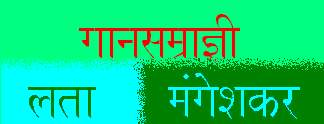
The greatest songster of all times
| Home | Life & Family | Awards | Did You Know | Others Have To Say | Lata's Fav Songs | Lata Hospital | Articles | Actresses |
| Lata Club | Lata Perfume | World's Largest Portrait | Solo List | Duet List | SS & Books | Amul Topicals |

The greatest songster of all times
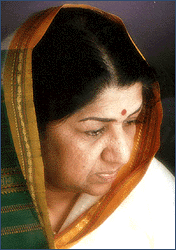
Bedard Tere Pyar
Ko (Padmini,1948; Ghulam Haider) - "In those days,
we had to record every song twice. Once for the film and again for the disc.
Ghulam Haider saab was the first major composer to give me a break. One night he
summoned me. I went immediately with my sister. While Haider saab sat at the
piano composing the song, my sister and I waited patiently throughout the night.
The next morning at 7.00 he was ready with the tune for 'Bedard tere pyar ko'.
Within a couple of hours I was ready for the take. A few days later I went back
to the HMV studio to record the song. This time in an abridged version. Soon
after Ghulam Haider saab migrated to Pakistan."
Aayega Aanewala (Mahal,1949; Khemchand Prakash) -
This was the song that defined the beginning of the
Mangeshkarian magic and transformed Madhubala into an instant living legend.
Ironically, Madhubala didn't lip-sync it on screen at all ! It was played in the
background. But what an impact it made ! With one song Lataji wiped away all the
careers of existing female singers. Ashok Kumar who played the lead in Mahal
still recalls how everyone in the room reacted when the then- unknown Lata was
asked to sing. Even today mention of Aaayega aanewala lights up Lataji's eyes.
"It's hundred percent my favourite. I had done a number of rehearsals for the
song. Actually the composer Khemchand Prakash heard me singing for Anil Biswas.
A number of tunes were readied for Aayega aanewala. I was given strict
instructions about the importance of the song. The producer Ashok Kumar and the
director Kamal Amrohi told me I had to sing as though the heroine was
approaching from a distance. Since the studio was very large, I was placed in
one corner of the room and told to gradually approach the microphone in the
middle of the room while singing. There were no dubbing and editing devices in
those days. We had to do it all in one go. I still remember we recorded the
entire day."
Aaj Mere Naseeb Ne
Mujhko (Hulchal,1951; Sajjad Hussain) - "Ah I really
like this one. Sajjad Husain's tunes were always a challenge. I was always
scared of singing his songs. He would come up really close to explain a song.
That made me nervous. But he wasn't a terror. He was a perfectionist. He taught
me how to sing an alaap in a subdued voice. Like me, he was from Indore and he
always reminded me of this fact. Unfortunately Aaj mere naseeb wasn't recorded
properly."
Aa Ri Aa Nindiya
(Do Bigha Zameen,1953; Salil Chowdhary) - "I think
this was Salilda's (Salil Chowdhary) first Hindi score. It was very difficult to
sing this number. There was no breathing space between the lines. Salilda
recorded two versions of the song, one with no orchestra. He wanted to create
the feeling of solitude as Meena Kumari sat singing all by herself." Phaili Hui Hai
Sapno (House No. 44, 1955; Sachin Dev Burman) - "Sachinda had his own style of putting across a composition to the
singer. He gave me the freedom to make suggestions. He had a deep knowledge of
folk music. He used to be very particular about the song situation. Being a
singer he could get exactly what he wanted from my voice. If he was pleased with
my singing he offered a paan which I happily accepted. I love paan."
Aaja Re Pardesi
(Madhumati, 1958; Salil Chowdhury) Salil Chowdhury is one of her
absolute favourite composers. "I love all the songs of Madhumati," the
Nightingale confesses excitedly, and blushingly remembers how happy everyone was
on the day Aaja re pardesi was recorded. "Lyricist Shailendra gave me flowers.
The director Bimal Roy came forward to congratulate me. The song was beautiful
and it was such a big hit too." The song won Lataji her first Filmfare award.
O Sajna Barkha
Bahaar (Parakh, 1960; Salil Chowdhary) - "I had
recorded the original version of this song for Salilda in Bengali as a Dusshera
Puja number. He often turned his Bengali compositions into Hindi numbers. Not
just me, everyone thinks O Sajna to be among Salilda's best creations."
Kaise Din Beete (Anuradha,1960; Pandit Ravi Shankar) -
"Hrishida's Anuradha was special. Pandit Ravi Shankar composed four lovely songs
for me. This one is my favourite. To sing for Panditji was a big event for me.
Woh itne bade artiste hain! I really respect him. When I rehearsed the song with
him, I was apprehensive. But he patiently explained what he wanted. We recorded
two songs of Anuradha in one day. After I saw the film I realized how well they
had been composed."
Allah Tero Naam(Hum
Dono, 1961; Jaidev) -When Dev Anand's Navketan banner decided to give
this prestigious assignment to S.D. Burman's assistant Jaidev. It was on
condition that Lataji sing for the film.The softie that she is Lataji
immediately set aside her differences with Jaidev to sing one of the tallest
devotional numbers ever. Classical vocalist Pandit Jasraj remembers waking up
from sleep with tears streaming down his streaming down his cheeks after hearing
the bhajan in Hum Dono. "Allah tero naam her very first song that we recorded
for the film," Lataji recalls. "Like Shankar - Jaikishan, Jaidev's tunes were
steeply scaled." Though she has sung at unbelievably high-pitch all her life
Lataji detests singing at what's traditionally the male scale. Ae Dilruba (Rustom
Sohrab, 1963; Sajjad Hussain) - "No list of my favourites can be
complete without this song. Sajjad Husain saab insisted that I don't stress any
sur in the composition. He wanted every note to be relaxed and unaccentuated. I
agree when you say my voice sounds completely different in this song. As usual I
was very scared during the recording. Like his songs, Sajjad saab was unique."
Woh Chup Rahen Toh
(Jahan Ara, 1964; Madan Mohan) - "It was a classical tune. After the
recording, I remember Madan bhaiyya came inside the recording room. He had tears
in his eyes. When he was deeply moved, he used to address me as beta. Jahan Ara
was Om Prakash's film. Om was my raakhi brother. He too was there during the
recording. Actually every song by Madan bhaiyya is important. Kis ko rakhen
kissko nahin... "
Naina Barse Rimjhim
(Woh Kaun Thi, 1964; Madan Mohan) -
Dil Ka Diya Jalaa
(Akash Deep, 1965; Chitragupta) - "A lovely song composed by a lovely
person. Chitragupta was like a family member. We visited each other all the
time. I would even drop in at his place for lunch if I was recording nearby. My
sisters, Usha and Meena, Chitragupta saab, his assistant Dilip Dholakia,
lyricist Prem Dhawan and I were all part of one group. We had great times
together. Later we stopped meeting frequently. But he only had to pick up the
phone and call me for a recording. I'll tell you a funny incident about
Chitragupta saab. Once I noticed his chappals were broken. He said it was his
lucky chappal. I turned around and quipped, 'Kyoon Chitragupta saab? Aapko apni
chappal par itna vishwas hai, aur hamare gaane par nahin?' Everyone burst out
laughing. For 'Dil ka diya' he wanted a very subdued sound. I sang it very
softly.
Duniya Kare Sawaal
(Bahu Begum 1967; Roshan) - "I simply adore this ghazal. The lyrics
by Sahir saab were excellent. The tune by Roshan was as usual, impeccable.
Roshan saab and I were friends. When he came to Mumbai in the 1940s, he stayed
in a garage with his wife. Their first son, Rakesh was born in that garage. He
had a vast knowledge of classical music and so did his wife. In fact Mrs Ira
Roshan and I once sang a duet for Anilda (Anil Biswas). Two other songs composed
by Roshan saab which I like very much are 'Rahen na rahen hum' from Mamata and
'Raat ki mehfil sooni sooni' from Noorjehan."
Kya Jaanoon Sajan
(Baharon Ke Sapne, 1967; R.D Burman) - "The double-voiced effect was
Pancham's idea. He recorded my voice with the musicians and then he projected
the recording into my headphones and asked me to overlap it. But even without
this experiment 'Kya jaanoon sajan' is a really haunting melody."
Dil-Vil Pyar-Vyar
(Shagird, 1967; Laxmikant Pyarelal) - "Let me tell you a story about
this song. Composers Laxmikant-Pyarelal would constantly throw ideas at each
other. Once we were recording a song with Majrooh Sultanpuri saab when I told
them about a person who always spoke in rhymes. He would say, "Main chai-wai
laaon ... Khana-wana khayen." Laxmikant immediately suggested to Majrooh saab
that we create a song on similar lines. That's how Dil-wil pyar-wyar was born.
The exclamation 'Aiyya!' became a rage. "
Chalo Sajana Jahan
Tak (Mere Humdam Mere Dost, 1968; Laxmikant Pyarelal) - "This one
ranks as one of my absolute favourites. I remember when recording the song,
Pyarelal, who seldom speaks, made some very useful suggestions on how I should
render the lines. I listened to him. The recording was over in a jiffy. It may
seem like a simple composition. But it's actually an intricate tune. It would
have been ruined if I rendered it without grasping the nuances."
Bhai Battoor
(Padosan, 1968; R.D Burman) - "Everyone prefers 'Sharm aatee hai
magar'. But I like 'Bhai battoor' better. The tune was simple enough. But the
alaaps that Pancham put in for me were challenging. I've sung many numbers like
'Sharm atee hai magar'. But Bhai battoor was unique. The recording continued for
many hours. At the end of it, I was quite exhausted. "
Aa Jaan-e-Jaan
(Inteqaam, 1969; Laxmikant-Pyarelal) - Cabaret songs used to be
sister Asha Bhosle's domain. Until Aa-jaane-e-jaan. Tuned and styled specially
to suit Lataji, Aa-jaan-e-jaan is today regarded as the best cabaret song in
Hindi films Tell her this, and Lataji laughs. "I remember telling Laxmikant not
to give me any cabaret songs to sing. He assured me I could swing it without a
hitch. Aa jaan-e-jaan was tailored to suit my taste and style." The song cracked
open the charts it's a favourite with Helen who danced to the opulently
orchestrated numbers.
Bindiya Chamkegi (Do
Raaste, 1969; Laxmikant-Pyarelal) - Filmmaker Raj Khosla was a man of
many talents, Music to him was life, A born singer he could hum tunes for
hours-together. Bindiya chamkegi was a Punjabi folk tune that Khosla had board
his mother singing. He wanted it in his film. Not a hot favourite with the
singer herself. Bindiya chamkegi brings the roof down at every live concert of
Lataji. When spectators break into a jig in the aisles the decorous Nightingale
baulks. But what to do. Its just one of those unavoidable things . Interestingly
Lataji sang this Punjabi-folk hit long before it became fashionable to have such
items in Hindi films.
Chalte-Chalte
(Paakeezah, 1972; Ghulam Mohammed) - "To be honest I am not too fond
of any of my songs in Paakeezah. But if you insist, I'd select Chalte chalte
over and above Thare rahiyo and Inhi logon ne. The tempo created by Ghulam
Mohamed saab in Chalte chalte was outstanding. My singing trails off and the
sitar and tabla take over. I never recorded a song unless I felt my voice was up
to the mark. There was a prevalent catchline about me in the music industry.
Aati nahin gaati nahin (laughs). My logic was simple. If I cancelled a recording
a hundred people suffered. But if I recorded without feeling up to the task,
what would thousands of listeners say?"
Bahon Mein Chale Aao
(Anamika , 1973; R.D Burman) - "Han, woh gaana bahut achcha hai. The
credit must go to R.D. Burman for explaining the entire situation in the film so
carefully. He was confident I'd grasp the mood. After every recording Pancham
would come and stand in front of me and exclaim, 'Fantastic! Kya gaaya aapne!' I
must also give credit to Jaya Bhaduri and Sanjeev Kumar for acting so well in
'Bahon mein chale aao'. Since the song is shot in the dead of the night I had to
sing in a hushed voice."
Chala Vahi Des (1974)
Music Director: Hridayanath Mangeshkar) - "I love every single song
in my brother Hridayanath Mangeshkar's bhajan albums. Meera bhajans have always
been my favourite." (Lataji refused to sing Pandit Ravi Shankar's compositions
in Gulzar's Meera, arguing she had already sung Meera bhajans for her brother).
When I recorded Chala vahi des I was so ill I could barely stand on my feet.
It's a project very close to my heart. During the recording, we maintained a
spiritual atmosphere all around us. Around the time we recorded the Meera
bhajans, neither my brother nor I recorded any film song. We had followed the
same pattern when we recorded my brother's compositions of the Bhagavad Geeta
earlier."
Satyam Shivam
Sundaram (Satyam Shivam Sundaram, 1978; Laxmikant Pyarelal) - "I like
the songs in this film because they were written by Pandit Narendra Sharma. I
was very close to him. The title song was okayed in one take. I also like
'Yashomati maiyya se bole Nandlala'. As an artiste I had a huge responsibility
on me. I first had to sing the lyrics in a child's voice (for Padmini Kolhapure)
and then as an adult (for Zeenat Aman)".
Dard Ki Ragini
(Pyaas, 1981; Bappi Lahiri) - "Bappi Lahiri could compose lovely
songs. Bappi's father had come to Mumbai to sing for a film called Badshah. But
he couldn't make any headway. We would meet whenever I visited Calcutta. I once
visited the Lahiris' home. Bappi was one year old then. His father clicked a
photograph with Bappi on my lap. Bappi still has that photograph framed on the
wall of his home. I sang his very first film song. He calls me Aunty."
Dikhayee Diye Yun
(Bazaar, 1981; Khayyam) - "What a song! I love every word in it. The
poet Mir Taqi Mir is among my personal favourites. I didn't see the film. I know
the composer Khayyam saab for decades. I liked even his earlier songs in
Footpath, etc. I think the first song I sang for him was 'Baharon mera jeevan
bhi sawaron' in Aakhri Khat. He has indepth knowledge of poetry. His songs are
composed in a specific style. But it's a very sweet style. He believes in going
into the nuances of a composition. A perfectionist and a gentleman to boot."
Aye Dil-e-Nadaan
(Razia Sultan, 1983; Khayyam) - "I like it so much because of the way
director Kamal Amrohi saab explained the song situation. He made it come alive
in front of my eyes. He said my Urdu was very chaste and clear. The day we
recorded Ae dil-e-nadaan I felt very happy. The lovely lyrics were by Javed
Akhtar's father Jan Nissar Akhtar. I've sung a number of his lyrics."
Shri Ram Bhajan &
Shyam Ghanshyam Barso (1985) Music Director: Shrinivas Kale) - "These
were the two solos I had in my album Ram Shyam Gun Gaan with Pandit Bhimsen
Joshi. Composer Shrinivas Kale is very popular among Marathi music listeners. I
had earlier sung for for him in Tukaram, which was a big hit. For this album I
was a little scared to match my vocals with an eminent classical vocalist like
Pandit Bhimsen Joshi. I agreed and even spoke to Pandit Narendra Sharma to write
the lyrics. A year earlier I had done the historic Ram Ratan Dhan Payo. I
understook this project because of Pandit Narendra Sharma who was a Ram Bhakt.
My brother and sister Usha composed some of the tunes. We are all composers in
our family."
Dil Deewana (Maine
Pyar Kiya, 1989; Raam Laxman) - Who would believe that Lataji was
ready to call it a day when she agreed to a sing this song for the little -known
Raam Laxman? And who would believes that Raam Laxman had originally prepared the
tune for a nondescript film called Agent Vinod for the Rajshris? "I was ill
during the recording of the songs in Maine Pyar Kiya and Chandni. Chandni was
specially painful for me. Though I was unwell, I recorded 5 songs for Maine Pyar
Kiya in one day." she concedes softly. It boosted the career of Raam Laxman who
had been struggling for more than a decade. It also turned around the slumping
fortunes of the HMV music company which according to rumours was on the verge of
closure. Finally Dil deewana helped Lataji to change her mind about quitting
playback singing. There was hope for film music.
Suniyoji Araj Mhari
(Lekin, 1990; Hridaynath Mangeshkar) - "Yara sili sili mein to chalne
wali baat thi. But my favourite in Lekin was Suniyo ji. Dimple emoted so
beautifully to the song! Gulzar saab who wrote the lyrics always says my brother
Hridayanath is a perfectionist, 'Woh aapko nahin chodte hain.' I know for sure
he'd never humour me by okaying an unsatisfactory take. He keeps recording until
he gets what he wants. His argument is, 'We can leave it as it is. But tomorrow
people are going to fault your rendition. I don't want that.' A lot of rival
composers have harmed his career. I feel bad for him. He never wanted me to
recommend him to filmmakers. It's a pity Lekin didn't run. I like the film. And
I love the songs. Even the background music is tremendous."
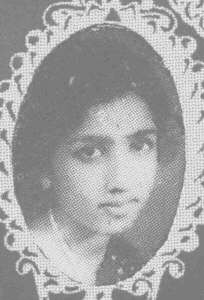 Bedard Tere
Pyar Ko [PADMINI] (1948) More
Bedard Tere
Pyar Ko [PADMINI] (1948) More
Aayega Aanewala [MAHAL] (1949) More
Aaj Mere Naseeb Ne Mujhko [HULCHAL] (1951) More
Aa Ri Aa Nindiya Tu Aaja [DO BIGHA ZAMEEN] (1953) More
Phaili hui hai sapnon ki baahein [HOUSE NO. 44] (1955)
More
Aaja Re
Pardesi[MADHUMATI](1958) More
O Sajana Barkha Bahar [PARAKH] (1960) More
Pyar Kiya To Darna Kya [MUGHAL-E-AZAM] (1960) More
Kaise Din Beete [ANURADHA] (1960) More
Allah Tero Naam [HUM DONO](1961) More
Kahin Deep Jale Kahin Dil [BEES SAAL BAAD] (1962) More
Ae Dilruba [RUSTOM SOHRAB] (1963) More
Woh Chup Rahe To [JAHAN ARA] (1964) More
Naina Barse
Rim Jhim[WOH KAUN THI](1964) More
Dil Ka Diya Jale [AKASHDEEP] (1965) More
Duniya Kare Sawal [BAHU BEGUM] (1967) More
Kya Janoon Sajan [BAHARON KE SAPNE] (1967) More
Dil-Vil Pyar-Vyar [SHAGIRD] (1967) More
Chalo Sajana [MERE HUMDUM MERE DOST] (1968) More
Bhai Batoor [PADOSAN] (1968) More
Aa jaane ja[INTEQUAM] (1969) More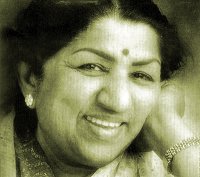 Bindiya Chamkegi [DO RAASTE](1969) More
Bindiya Chamkegi [DO RAASTE](1969) More
Chalte-Chalte [PAKEEZAH] (1972) More
Raaton Ke Saaye Ghane [ANNADATA] (1972) More
Bahon Mein Chale Aa [ANAMIKA] (1973) More
Chala Vahi Des (1974) More
Satyam Shivam Sundaram [SSS] (1978) More
Dard Ki Ragini [PYAAS] (1981) More
Dikhaye Diye Ki Bekhud [BAZAAR] (1981) More
Aye Dil-e-Nadaan [RAZIA SULTAN] (1983) More
Shri Ram Bhajan/Shyam Ghanashyam (1985) More
Dil
Deewana[MAINE PYAR KIYA](1989) More
Sunio Ji Araj Mhari [LEKIN] (1990) More
Kuch Na Kaho [1942 A LOVE STORY] (1994) More
Diya Jale [DIL SE](1998) More
What does Lata have to say about these
songs??
Lataji has lost count of the number of songs she has sung.
Some of the more popular numbers don't find favour with her. But there are
innumberable songs in her awesome repertoire which cannot be denied either on
merit or success. Songs that contributed to shaping one of the greatest success
stories of the 20th Century. Here's looking at some of Lataji's favourites and
why she likes them so immensely.
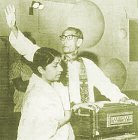
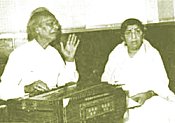 Pyar Kiya To Darna Kya (Mughal-e-Azam, 1960;
Naushad) - The image of Madhubala dancing in a thousand images
reflected on the walls of the sheesh mahal set is as alive today as it was in
the 60s. The lyric by Shakeel Badayuni has acquired the hue of an emblem
accentuating rebellious love. It was composed by Naushad who suggested the key
line Pyar kiya koi chori nahi ki to Badayuni. The line became the highlight of
the song. Naushad feels Lataji gave her best to Mughal-e-Azam. Listen to Lataji
sing Pyar kiya to darna kya and you'll know why the composing genius Sajjad
Hussain once exclaimed, "Lata sings, the others weep before the microphone."
Pyar Kiya To Darna Kya (Mughal-e-Azam, 1960;
Naushad) - The image of Madhubala dancing in a thousand images
reflected on the walls of the sheesh mahal set is as alive today as it was in
the 60s. The lyric by Shakeel Badayuni has acquired the hue of an emblem
accentuating rebellious love. It was composed by Naushad who suggested the key
line Pyar kiya koi chori nahi ki to Badayuni. The line became the highlight of
the song. Naushad feels Lataji gave her best to Mughal-e-Azam. Listen to Lataji
sing Pyar kiya to darna kya and you'll know why the composing genius Sajjad
Hussain once exclaimed, "Lata sings, the others weep before the microphone."
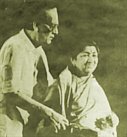 Kahin Deep Jale Kahin Dil (Bees Saal Baad, 1962; Hemant Kumar)
- Prior to this song, Lataji had fallen seriously ill. Doctors had
predicted that she'd never be able to sing again. Being a born fighter, the
Nightingale swore to bounce back. Her first recording after her illness was this
high-pitched number of haunting Dimensions. Lataji was nervous and apprehensive.
"Fortunately the recording went off very well. Hemant Kumar was of a very quiet
temperament. He knew exactly what to compose for me." Interestingly Hemant Kumar
recorded Lataji's voice during the rehearsal and okayed it as the final take,
the Nightingale says she's glad she made a comeback after her illness with an
intricate song like Kahin deep jale. She had a point to prove to her detractors
who were waiting for her downfalls and she proved it. The song won her another
Filmfare award.
Kahin Deep Jale Kahin Dil (Bees Saal Baad, 1962; Hemant Kumar)
- Prior to this song, Lataji had fallen seriously ill. Doctors had
predicted that she'd never be able to sing again. Being a born fighter, the
Nightingale swore to bounce back. Her first recording after her illness was this
high-pitched number of haunting Dimensions. Lataji was nervous and apprehensive.
"Fortunately the recording went off very well. Hemant Kumar was of a very quiet
temperament. He knew exactly what to compose for me." Interestingly Hemant Kumar
recorded Lataji's voice during the rehearsal and okayed it as the final take,
the Nightingale says she's glad she made a comeback after her illness with an
intricate song like Kahin deep jale. She had a point to prove to her detractors
who were waiting for her downfalls and she proved it. The song won her another
Filmfare award.
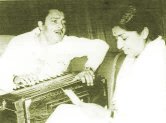
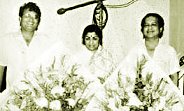
 Raaton Ke Saaye Ghane
(Annadata , 1972; Salil Chowdhury) - "Salilda was very fond of
Western classical music. He would not only buy recordings of symphony music for
himself, he also presented them to me. He would then explain the nuances of
Mozart, Beethoven, Bach, etc. Those were really wonderful days!" (Lata prefers
this classic beauty based on a Western symphony over her other raga-based
classical numbers from the early 1970s like R.D.Burman's Raina beeti jaaye' and
Beeti na beetayi raina.)
Raaton Ke Saaye Ghane
(Annadata , 1972; Salil Chowdhury) - "Salilda was very fond of
Western classical music. He would not only buy recordings of symphony music for
himself, he also presented them to me. He would then explain the nuances of
Mozart, Beethoven, Bach, etc. Those were really wonderful days!" (Lata prefers
this classic beauty based on a Western symphony over her other raga-based
classical numbers from the early 1970s like R.D.Burman's Raina beeti jaaye' and
Beeti na beetayi raina.)

